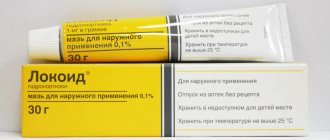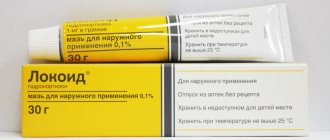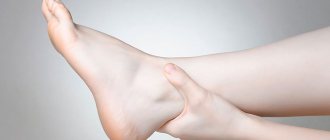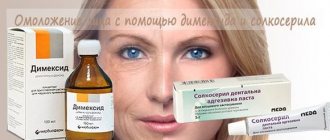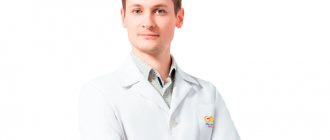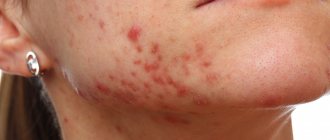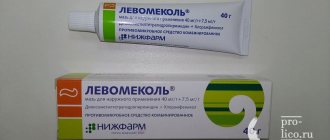Compound
- 1 gram of Triderm ointment contains 10 mg of clotrimazole , 1 mg of gentamicin , 0.5 mg of betamethasone . Additional components: liquid paraffin, soft paraffin.
- 1 gram of Triderm cream also contains 10 mg of clotrimazole , 1 mg of gentamicin , 0.5 mg of betamethasone . Additional components: propylene glycol, petrolatum, liquid paraffin, cetostearyl alcohol, benzyl alcohol, macrogol cetostearate, phosphoric acid, sodium dihydrogen phosphate dihydrate, water, phosphoric acid.
Main active ingredients, description
Triderm is a drug for local use with a complex effect. Available in the form of ointment and cream. 1 g of ointment includes:
- antifungal agent clotrimazole – 10 mg;
- antibiotic gentamicin – 1 mg;
- hormonal anti-inflammatory component betamethasone – 0.5 mg.
Additionally, liquid and soft paraffin are present to give the mass its shape. The substance has a uniform structure, translucent white or yellowish color, no pungent odor. Packaged in tubes of 15 or 30 g, each is sold in a box with instructions.
Pharmacodynamics and pharmacokinetics
Pharmacodynamics
Multicomponent product for external use. Combines the antipruritic, anti-inflammatory, antiallergic and antiexudative effect of betamethasone with the antifungal effect of clotrimazole and the antibacterial activity of gentamicin .
Clotrimazole has an antifungal effect due to its ability to inhibit the biosynthesis of ergosterol , which is an important structural unit of the fungal cell membrane. Effective on Epidermophyton floccosum, Trichophyton rubrum and mentagrophytes, Candida albicans, Microsporum canis, Malassezia furtur.
Gentamicin has a wide spectrum of effects. Exhibits a bactericidal effect and provides local treatment of bacterial skin lesions. Effective on:
- gram-negative bacteria – Proteus vulgaris, Pseudomonas aeruginosa, Escherichia coli, Klebsiella pneumoniae, Enterobacter aerogenes;
- gram-positive bacteria – Staphylococcus aureus.
Pharmacokinetics
There is no data on the pharmacokinetics of this drug.
Pharmacodynamics
Combined preparation for external use.
Triderm® ointment and cream combine the anti-inflammatory, antipruritic, antiallergic and antiexudative effect of the GCS betamethasone dipropionate with the antifungal activity of clotrimazole and the broad antibacterial effect of gentamicin sulfate.
Clotrimazole has an antifungal effect by disrupting the synthesis of ergosterol, which is an integral part of the cell membrane of fungi. Active against Trichophyton rubrum, Trichophyton mentagrophytes, Epidermophyton floccosum, Microsporum canis, Candida albicans, Malassezia furfur (Pityrosporum orbiculare).
Gentamicin sulfate, a broad-spectrum antibiotic from the aminoglycoside group, is bactericidal and provides highly effective local treatment of primary and secondary bacterial skin infections. Active against gram-negative microorganisms: Pseudomonas aeruginosa, Enterobacter aerogenes, Escherichia coli, Proteus vulgaris, Klebsiella pneumoniae; gram-positive microorganisms: Staphylococcus aureus (coagulase-positive, coagulase-negative and some strains producing penicillinase).
Indications for use
What does Triderm ointment and Triderm cream treat and for what? Indications for use of Triderm ointment:
- infections associated with microorganisms sensitive to the drug and frolicking against the background of dermatoses , or suspicion of them, including atopic , allergic and simple dermatitis , diffuse and limited neurodermatitis , dermatomycosis ( candidiasis , dermatophytosis , pityriasis versicolor ), eczema ;
- lichen simplex of a chronic nature.
Indications for Triderm®
Dermatoses complicated by infections caused by pathogens sensitive to the drug, or when such infections are suspected, including:
simple and allergic dermatitis;
atopic dermatitis (including diffuse neurodermatitis);
limited neurodermatitis;
eczema;
dermatomycosis (dermatophytosis, candidiasis, lichen versicolor), especially when localized in the groin area and large folds of the skin;
simple chronic lichen (limited neurodermatitis).
Contraindications
- skin symptoms of syphilis ;
- chicken pox;
- lupus ;
- post-vaccination skin reactions;
- herpes simplex;
- hypersensitivity to the components of the drug;
- age less than 2 years.
It is recommended to use the drug with caution for long-term therapy, in children over 2 years of age, during pregnancy, on large areas of skin or in the presence of wounds, when applying occlusive dressings.
Contraindications for the use of ointment, possible side effects
Triderm ointment is not used in case of individual intolerance or hypersensitivity to any of the substances in the composition.
Also, the medication is not used:
- skin lesions due to tuberculosis;
- with syphilis;
- chickenpox;
- skin reactions to vaccine administration;
- herpetic rashes;
- chicken pox;
- open wounds;
- in the treatment of children under two years of age.
The ointment can be used with caution during pregnancy, in pediatrics, when using bandages, for long courses and on large areas of the skin.
Adverse reactions occur rarely. These are mainly local unpleasant sensations - burning, itching, severe redness, wetting of the skin at the site of application.
The manufacturer also points out the possibility of side effects that have been recorded when using glucocorticosteroids:
- stretch marks;
- prickly heat;
- feeling of dryness;
- increased hair growth;
- acne;
- secondary infection;
- swelling or atrophy of the skin.
Due to the action of clotrimazole, the following may occur: tingling, blisters, swelling at the site of application, peeling and itching, redness, and urticaria-type rashes.
Side effects
- Local phenomena: erythema , burning sensation, pigmentation disorder, exudation , itching.
- Side effects after using local glucocorticosteroids : itching, burning sensation, folliculitis , dry skin, hypertrichosis, hypopigmentation, acne, allergic contact dermatitis , skin maceration, perioral dermatitis , atrophy , secondary infection, prickly heat , stretch marks .
- Side effects after using clotrimazole : urticaria , tingling sensation, erythema , peeling, blistering, itching, local swelling, irritation.
- Side effects after using gentamicin : temporary erythema and itching, which does not require discontinuation of therapy.
ABOUT THE DRUG:
The combined drug has anti-inflammatory, antiallergic, antibacterial and antifungal (fungicidal) effects.
INDICATIONS AND DOSAGE:
- Simple contact and allergic dermatitis (especially complicated by secondary bacterial infection)
- Atopic dermatitis, eczema
- Dermatomycosis (dermatophytosis, candidiasis, pityriasis versicolor), especially when localized in the groin area and large folds of skin
- Lichen simplex chronicus
- Seborrheic dermatitis
- Dermatoses amenable to therapy with glucocorticosteroids
- Psoriasis
Adults and children over 7 years old:
A small amount of cream is applied to the affected areas of the skin, lightly rubbing, 2 times a day. The duration of treatment is determined individually by the doctor and depends on the nosological form and severity of the disease. The drug should not be used under an occlusive dressing, and treatment should not be carried out without a break for more than 2 weeks; a break of at least 20 days is required between repeated courses. For tinea pedis, the average duration of treatment is 2-4 weeks.
The course of treatment in children and patients with facial lesions should be no more than 5 days.
OVERDOSE:
Symptoms: arterial hypertension, secondary infections, Cushing's syndrome; after prolonged use on a large surface of the skin, hypercortisolism may occur.
Treatment: gradual withdrawal of the drug, if necessary, correction of electrolyte disturbances, symptomatic therapy.
SIDE EFFECTS:
- Itching, burning, irritation
- Dry skin, folliculitis, hypertrichosis, steroid acne, hypo- or hyperpigmentation
- Allergic reactions
- Perioral dermatitis, telangiectasia
- Maceration, infection, skin atrophy, stretch marks, miliaria (when using occlusive dressings)
- With prolonged treatment or application to a large surface, systemic side effects may develop:
- Increased body weight, osteoporosis, increased blood pressure, edema, hyperglycemia,
- Ulceration of the gastrointestinal mucosa
- Exacerbation of hidden foci of infection
- Excitement, insomnia
- Suppression of the pituitary-adrenal system, dysmenorrhea
- Ototoxic effect
CONTRAINDICATIONS:
- Hypersensitivity to the components of the drug
- Skin tuberculosis, skin manifestations of syphilis
- Chickenpox, herpes simplex and other viral skin diseases
- Skin post-vaccination reactions
- Open wounds
- Phlebitis, trophic ulcers
- Skin neoplasms
- Rosacea and acne acne
- Diabetes
- Glaucoma, cataract
- Children's age up to 7 years
The use of Tridox during pregnancy is possible only if the expected benefit to the mother outweighs the potential risk to the fetus. It is not known whether the components of the drug are excreted in breast milk. Therefore, when prescribing Tridox during lactation, the issue of stopping breastfeeding should be decided.
INTERACTIONS WITH OTHER MEDICINES AND ALCOHOL:
Strengthens the effect of immunosuppressants, reduces the effect of immunostimulating drugs.
COMPOSITION AND PROPERTIES:
1 g of cream contains:
active ingredients: betamethasone dipropionate 0.64 mg equivalent to betamethasone 0.50 mg, clotrimazole 10.00 mg, gentamicin sulfate equivalent to gentamicin 1.00 mg,
excipients: cetostearyl alcohol, cetomacrogol 1000, white soft paraffin, light liquid paraffin, propylene glycol, sodium metabisulfite, hydroxytoluene butoxide, EDTA disodium salt, disodium hydrogen phosphate, sodium dihydrogen phosphate, glyceryl monostearate, methylparaben, propylparaben, purified water.
Release form:
- Cream.
Pharmachologic effect:
Betamethasone dipropionate is a synthetic fluorinated glucocorticosteroid (GCS). It has anti-inflammatory, antipruritic, antiallergic, vasoconstrictive effects. The drug induces the synthesis of lipocortin, which leads to inhibition of phospholipase A2 activity and a decrease in the biosynthesis of inflammatory and allergic mediators, such as prostaglandins and leukotrienes. Eliminates increased permeability and dilation of blood vessels in the area of damage, as a result of which it reduces exudative reactions. Reduces protein synthesis, collagen deposition, inhibits proliferative processes in the skin.
Clotrimazole is an antifungal agent from the group of imidazole derivatives. It has an effect by disrupting the synthesis of ergosterol, which is an integral part of the cell membrane of fungi. Has a wide spectrum of action. Effective against dermatophytes, molds, fungi of the genus Candida, as well as the causative agent of pityriasis versicolor - Malassezia furfur. Active against gram-positive and gram-negative bacteria: Corynebacterium minutissimum, Streptococcus spp., Staphylococcus spp., as well as against Trichomonas vaginalis.
Gentamicin is a broad-spectrum antibiotic from the group of aminoglycosides that has a bactericidal effect. The bactericidal effect is due to impaired permeability of the cytoplasmic membrane and inhibition of protein synthesis at the ribosome level. Gram-negative bacteria are highly sensitive to the drug: Proteus spp. (indole-positive and indole-negative), Escherichia coli, Klebsiella spp., Salmonella spp., Shigella spp., Campylobacter spp.; gram-positive bacteria: Staphylococcus spp. (methicillin-resistant). Sensitive: Enterococcus faecalis, Serratia spp., Pseudomonas spp., Acinetobacter spp., Citrobacter spp. Resistant: Neisseria meningitidis, Treponema pallidum, Streptococcus spp. (except Streptococcus pneumoniae), Providencia rettgeri.
Storage conditions:
Store at a temperature not exceeding 25 ºС.
Instructions for use of Triderm (Method and dosage)
Triderm ointment, instructions for use
The ointment is for external use only.
The use of Triderm ointment is carried out in the following way: a thin layer is applied to the affected and surrounding skin twice a day (morning and evening). To ensure a therapeutic effect, the product must be applied regularly. The duration of treatment depends on the size and location of the lesion, as well as the response to therapy.
If improvement is registered after 4 weeks of treatment, you should consult a doctor and clarify the diagnosis.
Triderm cream, instructions for use
The cream is for external use only. The method of application and dosage when using the cream are completely consistent with those when using the ointment.
What effect does Triderm ointment have?
The instructions for Triderm ointment indicate that the drug belongs to the group of anti-inflammatory, antifungal and antibacterial agents.
The therapeutic effect of the drug is due to the properties of its constituent components:
- clotrimazole – has antifungal activity, promotes the destruction of cells of pathogenic dermatophytes, yeast and mold fungi;
- gentamicin is a broad-spectrum antibiotic that is harmful to gram-positive and gram-negative bacteria (staphylococci, Klebsiella, Escherichia coli, Proteus);
- betamethasone is a glucocorticosteroid that has antiallergic and anti-inflammatory effects, relieves itching and swelling at the site of injury.
Overdose
Signs of overdose with local glucocorticosteroids : with long-term use in large doses, suppression of adrenal function with the appearance of adrenal insufficiency and hypercortisolism .
An overdose of clotrimazole when applied locally does not lead to the development of any symptoms.
In case of an overdose of gentamicin, no symptoms are detected either. Long-term treatment with gentamicin in large doses may cause the appearance of insensitive flora.
Overdose therapy: symptomatic. Acute hypercortisolism is usually reversible. If necessary, correct electrolyte imbalance. In case of chronic overdose of local glucocorticosteroids, slow withdrawal is recommended.
In what cases will Triderm help?
The drug has a wide range of applications. The ointment can be applied to dermatoses with existing signs of infection or to prevent bacterial complications in dermatological diseases.
The manufacturer indicates the following list of indications:
- dermatitis, simple or allergic in origin;
- eczema;
- atopic dermatitis syndrome, neurodermatitis;
- manifestations of simple chronic lichen;
- diseases of fungal origin, for example, candidiasis, lichen versicolor, located in the groin area and large skin folds.
special instructions
Triderm ointment and cream are not intended for use in ophthalmic practice.
Prolonged use of local antibiotics in some cases can lead to the emergence of resistant microflora. In such a case, as well as in case of sensitization , irritation or superinfection , Triderm therapy should be stopped and symptomatic treatment should be started. Cross allergic phenomena with aminoglycoside antibiotics cannot be excluded .
All side effects that occur when taking systemic glucocorticosteroids , including suppression of the adrenal cortex, can also develop when using local glucocorticosteroids , especially in children.
The absorption of active substances into the systemic circulation when applied topically is enhanced if treatment is carried out with the application of occlusive dressings or over large areas of the skin, especially during prolonged treatment or when the skin is wounded. It is strongly recommended to avoid contact of gentamicin with open wounds or broken skin, as this may cause adverse reactions characteristic of systemic use of gentamicin .
With long-term use of the drug, its withdrawal should be carried out slowly.
There was no effect of the drug on the ability to drive vehicles.
Additional recommendations
The ointment is not used for infectious diseases of the organs of vision. With long-term use of a local antibiotic, pathogenic microorganisms may develop resistance to it.
Do not apply the product to open wound surfaces or severely damaged skin. The use of dressings and application of the product to large areas of skin contribute to higher absorption of gentamicin and glucocorticosteroids, resulting in an increased risk of adverse reactions.
If use has been long-term, then it should be discontinued gradually.
Triderm's analogs
Level 4 ATX code matches:
Rederm
Losterine
Akriderm SK
Akriderm
Akriderm GK
Akriderm Genta
Elokom S
Diprosalik
Belosalik
Kanizon Plus
Betasalik
Triacutan
Momat-S
Analogues of Triderm cream and ointment: Akriderm (Russian substitute), Kanizon , Triakutan, Betazon Ultra, Lokoid, Diprosalik, Betasalik.
The price of analogues of Triderm ointment, which are listed above, is an order of magnitude lower than the price of the product itself.
For children
The medicine is prescribed only to children over 2 years of age, according to strict indications and under the supervision of a doctor, since it is possible that systemic side effects associated with betamethasone appear in this category of patients more often than in adults. Such side effects include: Cushing's syndrome , inhibition of the pituitary-hypothalamic-adrenal system , growth retardation, increased intracranial pressure (as a consequence, headache, swelling of the optic nerve and bulging of the fontanelles), slower growth of body weight.
Triderm ointment 15g No. 1
Name
Triderm.
Release forms
Ointment.
Compound
1 g of ointment contains: active ingredients: betamethasone dipropionate equivalent to betamethasone 0.5 mg, clotrimazole 10 mg and gentamicin sulfate equivalent to gentamicin 1 mg; excipients: liquid paraffin, white petroleum jelly.
Description
Soft consistency, white to light yellow, homogeneous ointment, without foreign inclusions.
Pharmacotherapeutic group
Corticosteroids for use in dermatology. Corticosteroids are highly active in combination with other drugs. ATC code: D07XC01.
Pharmacological properties
The mechanism of action of Triderm combines the following mechanisms of action: the anti-inflammatory effect of betamethasone dipropionate, the antibacterial effect of gentamicin and the antifungal effect of clotrimazole.
Pharmacodynamics
Betamethasone in the form of dipropionate is a potent corticosteroid (class III) with anti-inflammatory, antiallergic and antipruritic effects. Gentamicin is an aminoglycoside antibiotic with antibacterial activity. Its action is based on suppressing the synthesis of proteins of sensitive microorganisms. Gentamicin affects many aerobic gram-negative and some gram-positive bacteria. In vitro, gentamicin at concentrations of 1-8 μg/ml inhibits the growth of most sensitive strains of Escherichia coli (Escherichia coli), Haemophilus influenzae (Haemophilus influenzae), Moraxella lacunata (Morax-Axenfeld sticks), Neisseria (Neisseria), indole-positive and indole-negative Proteus, Pseudomonas (pseudomonas), including most strains of Pseudomonas aeruginosa, Staphylococcus aureus, Staphylococcus epidermidis and Serratia. Different species and different strains of the same species may exhibit large differences in susceptibility under in vitro conditions. In addition, in vitro sensitivity does not always correlate with in vivo sensitivity. Gentamicin is not effective against most anaerobic bacteria, fungi and viruses. Gentamicin has only minimal effect on streptococci. Resistance to gentamicin can develop in both gram-negative and gram-positive bacteria. Clotrimazole is a synthetic antifungal agent - an imidazole derivative. The spectrum of action covers a number of fungi that are pathogenic for humans and animals. Clotrimazole is effective against dermatophytes, yeasts and molds. In in vitro assays, clotrimazole was effective against the fungi Trichophyton rubrum, Trichophyton mentagrophytes, Epidermophyton floccosum, Microsporum canis and fungi of the genus Candida, including Candida albicans. According to current knowledge, the antifungal effect of clotrimazole is explained by the inhibition of ergosterol synthesis. Ergosterol is a vital component of the cell membrane of fungi.
Pharmacokinetics
There are no data on the pharmacokinetics of Triderm. Betamethasone Under normal conditions, when applied topically, only a portion of betamethasone enters the systemic circulation. The percentage of penetration and absorption depends on the body area, skin condition, dosage form, age and method of application. Gentamicin When gentamicin is applied to intact skin, absorption is unlikely to be expected. If the keratin layer is damaged, inflamed, used under an occlusive dressing, or applied to a large area, increased percutaneous absorption should be expected. Clotrimazole Most of the applied clotrimazole remains in the stratum corneum, and absorption into the systemic circulation is negligible. 6 hours after applying 1% radioactive clotrimazole to healthy skin, as well as to skin with acute inflammation, the following concentrations could be determined: stratum corneum - 100 μg/cm3, reticular layer - 0.5-1 μg/cm3, subcutaneous tissue - 0.1 µg/cm3.
Indications for use
Triderm is indicated for the treatment of corticosteroid-sensitive dermatoses in which bacterial and/or fungal infection either already exists or is to be feared.
Contraindications
Skin infections (viral, bacterial
incl. tuberculosis
, as well as fungal origin), reactions to vaccines, skin ulcers and acne are contraindications for the use of topical corticosteroids. If you have rosacea or perioral dermatitis, you should avoid applying the ointment to your face. Hypersensitivity to one of the active or excipient substances of the drug, to other aminoglycoside antibiotics (cross-allergy with gentamicin) or imidazole derivatives (cross-allergy with clotrimazole). Triderm is not intended for use under an occlusive dressing. Triderm should not be applied to mucous membranes, skin around the eyes or near the eyes.
Directions for use and dosage
Adolescents and adults 2 times a day (morning and evening), apply a thin layer to the affected areas of the skin and rub in lightly, covering both the entire affected area and the healthy surface of the skin surrounding it. The duration of treatment depends on the results of both clinical examination and microbiological examination, as well as on the response to treatment. For athlete's foot, the need for longer treatment (2-4 weeks) may be considered. Children from 2 to 12 years Apply a small amount only to affected areas of skin and rub in gently. Use no more than twice a day, taking a break of at least 6-12 hours between applications of the ointment. Apply the ointment to the face, neck, scalp, genital area, rectal area and areas with diaper rash under the supervision of a physician. The duration of treatment is limited to 5-7 days. See sections "Precautions" and "Use in pediatric patients".
Adverse reactions
At the beginning of treatment Skin Rarely: irritation, burning, itching, dryness, hypersensitivity reactions to any of the ingredients of the drug and changes in skin color. When used over large areas, under an occlusive dressing and/or with longer use. When used over large areas, under an occlusive dressing and/or with longer use, local skin changes are possible. When applying the ointment to large areas, there is a possibility of systemic effects (suppression of adrenal cortex function). It should be taken into account that due to reduced local resistance to infections, there is an increased risk of secondary infections. Skin Local skin changes such as atrophy (especially on the face), telangiectasias, striae, stripe-like skin atrophy, skin hemorrhages, purpura, steroid acne, rosacea-like or perioral dermatitis, hypertrichosis, and changes in skin color. It is not known whether skin color changes are reversible. Sometimes: contact hypersensitivity to gentamicin. In some patients, possible photosensitivity was observed, which, however, did not resume with repeated application of gentamicin followed by exposure to ultraviolet radiation. Endocrine system Suppression of the synthesis of endogenous corticosteroids, hypercortisolism with edema. Metabolism Diabetes mellitus (manifestation of a previously hidden form). Ear, inner ear/kidney Cumulative ototoxicity/nephrotoxicity should be expected during treatment with large areas of ointment or use on broken skin with concomitant systemic use of aminoglycoside antibiotics. Musculoskeletal system Osteoporosis, growth retardation (in children). Systemic adverse reactions, such as blurred vision, have also been reported with the use of topical corticosteroids. If the listed adverse reactions occur, as well as reactions not listed in the instructions for use, you should consult a doctor.
Overdose
Symptoms: with prolonged or excessive use of local glucocorticosteroids, suppression of pituitary-adrenal function with the development of secondary adrenal insufficiency and the appearance of symptoms of hypercortisolism, including Cushing's syndrome, are possible. A single overdose of gentamicin is not expected to cause any symptoms. The use of clotrimazole under an occlusive dressing for 6 hours did not lead to the development of overdose symptoms. Excessive or prolonged use of gentamicin may lead to overgrowth of microorganisms that are not sensitive to the antibiotic. Treatment: appropriate symptomatic therapy is prescribed. Symptoms of acute hypercortisolism are usually reversible. If necessary, electrolyte balance is corrected. In case of chronic toxicity, gradual withdrawal of corticosteroids is recommended. If there is excessive growth of resistant microorganisms, it is recommended to stop treatment with Triderm and prescribe the necessary therapy.
Precautionary measures
If irritation or sensitization occurs due to the use of Triderm, treatment should be discontinued and appropriate therapy should be initiated. The absorption of active substances intended for topical use into the systemic circulation may be enhanced if Triderm is applied over a large area, in particular with long-term use or use on damaged skin. Under these conditions, undesirable effects may occur in the form in which they appear after systemic use of active substances. When used in children in such cases, extreme caution is recommended. In case of simultaneous systemic use of aminoglycoside antibiotics, with increased percutaneous absorption, cumulative toxic effects (ototoxicity, nephrotoxicity) should be expected. The possibility of possible cross-allergy to other aminoglycoside antibiotics should be taken into account. With long-term treatment with drugs containing antibiotics, insensitive microorganisms may appear. In this case or if superinfection occurs, appropriate therapy should be started. High-dose, large-scale or occlusive application of a potent or very potent corticosteroid should only be done under regular medical supervision, especially given the suppression of endogenous corticosteroid production and possible metabolic effects. Avoid use on open wounds and damaged areas of skin. The period of continuous use, if possible, should not exceed 2-3 weeks. Very strong, strong and moderate-acting corticosteroids should be used on the face and genital area with extreme caution and for no longer than 1 week. In principle, only weak corticosteroids are used near the eyes (due to the risk of developing glaucoma). Corticosteroids may mask the symptoms of an allergic skin reaction to the drug's ingredients. The patient should be instructed to use the drug only for the treatment of his current skin condition and not to give the drug to others. When using systemic and local corticosteroids (including intranasal, inhaled and intraocular administration), visual disturbances may occur. If symptoms such as blurred vision or other visual disturbances occur, the patient should be evaluated by an ophthalmologist to evaluate possible causes of the visual disturbance, which may include cataracts, glaucoma, or rare diseases such as central serous chorioretinopathy, which has been reported following the use of corticosteroids systemic and local action. Use in pediatric patients This medicinal product is not recommended for use in children under 2 years of age. Pediatric patients may be more sensitive than adult patients to hypothalamic-pituitary-adrenal axis suppression and exogenous corticosteroid activity caused by topical corticosteroids because the greater ratio of skin surface area to body weight results in greater absorption. Suppression of the hypothalamic-pituitary-adrenal axis, Cushing's syndrome, decreased linear growth, decreased weight gain, and increased intracranial pressure have been reported with the use of topical corticosteroids in children. Symptoms of adrenal suppression in children include, among other things, low plasma cortisol levels and lack of response after adrenocorticotropic hormone (ACTH) stimulation. Symptoms of increased intracranial pressure include bulging fontanel, headaches, and bilateral papilledema, among others.
Use during pregnancy or breastfeeding
Pregnancy: In animal testing, topical corticosteroids were teratogenic. There are no data on use in pregnant women. Aminoglycosides cross the placental barrier and may cause fetal harm if taken by pregnant women. There have been reports of complete irreversible bilateral congenital deafness in children whose mothers took aminoglycosides, including gentamicin, during pregnancy. There are no sufficient data on the topical use of gentamicin in pregnant women. There are no sufficient data on the use of clotrimazole in pregnant women. Results from animal studies did not reveal any risks to the fetus. Triderm should only be used in cases where it is absolutely necessary. Triderm should not be used over a large area, in large quantities or for a long time. Breastfeeding There is no data on the excretion of gentamicin, clotrimazole and topical corticosteroids into breast milk, but corticosteroids that enter the systemic circulation also pass into breast milk. When applying Triderm to the mammary glands, breastfeeding is contraindicated.
The ability to influence the reaction rate when driving a vehicle or working with other mechanisms
As a rule, the drug does not affect the speed of reaction when driving vehicles or operating other mechanisms.
Interaction with other drugs and other types of interactions
Due to the content of white soft paraffin and liquid paraffin, the tensile strength and, therefore, the safety of using latex condoms may be reduced; this should be taken into account when using the ointment in the genital or anal area. When applied topically, clotrimazole may have an antagonistic effect on amphotericin and other polyene antibiotics.
Best before date
3 years. It is not recommended to use the drug after the expiration date indicated on the package.
Storage conditions
Store out of the reach of children at a temperature not exceeding 25°C.
Package
15 g in aluminum tubes. One tube each along with instructions for use in a cardboard box.
Vacation category
On prescription.
Buy Triderm ointment 15g No. 1 in the pharmacy
Price for Triderm ointment 15g No. 1
Instructions for use for Triderm ointment 15g No. 1
Reviews about Triderm
Reviews of the cream, as well as reviews of Triderm ointment, report rare cases of ineffectiveness and even more rarely undesirable effects (mainly itching). Otherwise, 90% of reports give an excellent rating to the drug. Due to the complex composition and the possibility of severe side effects, it is not recommended to use this medicine independently and unsupervised.
Is Triderm ointment hormonal or not?
The ointment and cream of the same name contain the hormonal component betamethasone , so they can be called hormonal.
Triderm and balanoposthitis
Despite the good results of treating balanoposthitis with this remedy, many doctors do not recommend its use for this pathology, due to the high probability of damage to the skin of the genitals under the influence of hormones.
Cream or ointment: which is better?
Reviews do not reveal any significant correlation between the effectiveness of these forms of release of the drug.
Triderm price, where to buy
The price of Triderm ointment 15 g in Russia is 570-680 rubles, and cream 15 g costs 580-640 rubles. Buying a cream in Moscow (like ointment) will cost a large amount; here its cost reaches 820 rubles.
Ointment 15 g costs 230-300 hryvnia in Ukraine. The price of Triderm cream 15 g is on average 230-290 hryvnia.
- Online pharmacies in RussiaRussia
- Online pharmacies in UkraineUkraine
- Online pharmacies in KazakhstanKazakhstan
ZdravCity
- Triderm cream 15gSchering-Plough Labo NV
RUR 775 order - Correction of photoaging Hyaluronic acid + ampoules MartiDerm/MatriDerm Platinum 2ml No. 10MARTIDERM, SL ES
RUR 4,214 order
- Correction of photoaging Hyaluronic acid + ampoules MartiDerm/MatriDerm Platinum 2ml No. 30MARTIDERM, SL ES
6650 rub. order
Pharmacy Dialogue
- Triderm ointment (tube 15g)Shering-Plough
RUR 799 order
- Triderm cream tube 15gShering-Plough
RUB 755 order
show more
PaniPharmacy
- Triderm cream Triderm cream 30g Belgium, Schering-Plough Labo
295 UAH.order - Triderm cream Triderm cream 15g Belgium, Schering-Plough Labo
187 UAH order
- Triderm ointment Triderm ointment 15g Belgium, Schering-Plough Labo
190 UAH order
- Triderm ointment Triderm ointment 30g Belgium, Schering-Plough Labo
345 UAH. order
show more


